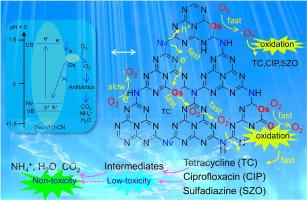Chemical Engineering Journal ( IF 15.1 ) Pub Date : 2022-09-26 , DOI: 10.1016/j.cej.2022.139434 Yunxiong Zeng , Xingyu Zhan , Bo Hong , Yingchun Xia , Yangbin Ding , Tao Cai , Kai Yin , Xingqin Wang , Liming Yang , Shenglian Luo

|
Recently, antibiotic pollution has aroused great concern due to its toxicity to living organisms and the risk of drug-resistance gene generation in the ecosystem. Carbon nitride (CN) photodegradation towards antibiotics is a promising technology for water purification. However, CN possesses a low activity due to the fast recombination of electron-hole pairs and slow reaction kinetics. Herein, we report the fabrication of nitrogen-vacancy and oxygen-substitution modified carbon nitride ((Nv, Os)–CN) with a rearranged surface via a low-temperature thermal oxidation strategy. The (Nv, Os)–CN can degrade tetracycline (TC), ciprofloxacin (CIP) and sulfadiazine (SZO) than CN under visible light irradiation efficiently. The first-order kinetic constant of (Nv, Os)–CN for TC, CIP and SZO was 2.1, 2.24 and 1.38 folds higher than those of CN, respectively. This high performance benefits from the rearranged surface atoms by forming an active surface with rich Nv and Os, thus promoting interfacial charge transfer and building robust water-(Nv, Os)–CN interface. In addition, the possible photodegraded pathways, resulting intermediates and risks of TC photodegradation were analyzed by the LC-MS and QSAR methods. Our proposed low-temperature thermal oxidation strategy to achieve surface atom rearrangement endows CN with an enhanced photoactivity toward antibiotics degradation.
中文翻译:

氮化碳表面原子重排增强可见光下抗生素的光催化降解
近年来,抗生素污染因其对生物体的毒性和生态系统中产生耐药基因的风险而引起了人们的极大关注。氮化碳(CN)光降解抗生素是一种很有前途的水净化技术。然而,由于电子-空穴对的快速复合和缓慢的反应动力学,CN 具有低活性。在此,我们报告了通过低温热氧化策略制备具有重排表面的氮空位和氧取代改性的氮化碳((Nv,Os)-CN)。(Nv, Os)-CN 在可见光照射下比 CN 能更有效地降解四环素 (TC)、环丙沙星 (CIP) 和磺胺嘧啶 (SZO)。(Nv, Os)-CN 对 TC、CIP 和 SZO 的一级动力学常数分别是 CN 的 2.1、2.24 和 1.38 倍。这种高性能得益于重新排列的表面原子,通过形成具有丰富 Nv 和 Os 的活性表面,从而促进界面电荷转移并建立稳健的水-(Nv, Os)-CN 界面。此外,通过LC-MS和QSAR方法分析了可能的光降解途径、产生的中间体和TC光降解的风险。我们提出的实现表面原子重排的低温热氧化策略赋予了CN增强的抗生素降解光活性。通过 LC-MS 和 QSAR 方法分析了产生的中间体和 TC 光降解的风险。我们提出的实现表面原子重排的低温热氧化策略赋予了CN增强的抗生素降解光活性。通过 LC-MS 和 QSAR 方法分析了产生的中间体和 TC 光降解的风险。我们提出的实现表面原子重排的低温热氧化策略赋予了CN增强的抗生素降解光活性。



























 京公网安备 11010802027423号
京公网安备 11010802027423号